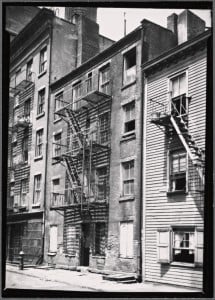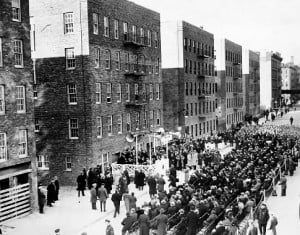Blog Archive
Great Question: How Did Slum Clearance Impact Neighborhoods?
Questions posed by our visitors lead to great conversations. Occasionally, we’ll post a great question that’s frequently asked, along with the answer, to give you a bit of back story on our exhibits.
When tenements were scheduled to be razed as part of a slum clearance program, were they demolished right away? What happened to the families who were displaced?
From their inception, the processes of slum clearance and urban renewal did not proceed at an orderly, even pace, but took place gradually as federal and municipal authorities assembled a series of conjoining sites through eminent domain and condemnation. Once a section of the neighborhood was slated for destruction and renewal, already poor housing conditions deteriorated further and faster.
Before condemned buildings were demolished, absentee landlords cut back on maintenance in order to maximize rental income from their soon-to-be torn down buildings. Initially, at least, the result was not block-long stretches of boarded-up, vacant buildings, but populated tenements interspersed with already condemned residences. Once the authorities had condemned all of the buildings in a given area and evicted all of the residents, demolition and construction was supposed to proceed on a predetermined schedule, a process that usually took years, sometimes a decade, to complete. However, areas slated for renewal often lay vacant for years before anything was built. As a study of slum clearance in Brownsville, Brooklyn observed, “Block after block has been left vacant, forming a wasteland of gutted carcasses of buildings and rat filled rubble.”
Many former tenement residents moved into public housing units, the first of which (called the First Houses) were built on the Lower East Side in 1935, the same year that 97 Orchard Street officially closed to residents. Some received financial help to cover the cost of moving.
In May of 1934, the New York Times reported that “Several hundred families compelled to leave their homes by reason of slum clearances…are not being forced to bear the extraordinary expense of moving unless they can bear it…” The story goes on to explain that representatives of the Tenement House Department visited families to determine their need, granting vouchers to cover one month’s rent to those who were most impoverished.
— Posted by Kira Garcia

